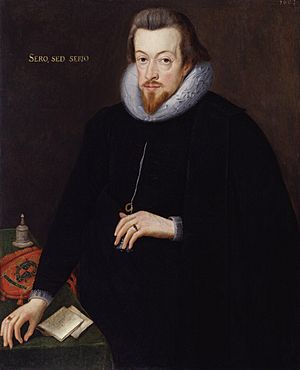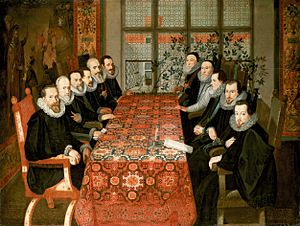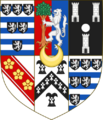Robert Cecil, 1st Earl of Salisbury facts for kids
Quick facts for kids
The Earl of Salisbury
|
|
|---|---|

The Earl of Salisbury by John de Critz the Elder c. 1602
|
|
| Lord High Treasurer | |
| In office 4 May 1608 – 24 May 1612 |
|
| Monarch | James I |
| Preceded by | The Earl of Dorset |
| Succeeded by | The Earl of Northampton (as First Lord) |
| Lord Privy Seal | |
| In office 1598–1608 |
|
| Monarch | Elizabeth I James I |
| Preceded by | The Lord Burghley |
| Succeeded by | The Earl of Northampton |
| Chancellor of the Duchy of Lancaster | |
| In office 8 October 1597 – 1599 |
|
| Monarch | Elizabeth I |
| Preceded by | In commission |
| Succeeded by | In commission |
| Secretary of State | |
| In office 5 July 1596 – 24 May 1612 |
|
| Monarch | Elizabeth I James I |
| Preceded by | William Davison |
| Succeeded by | John Herbert |
| Personal details | |
| Born | 1 June 1563 Westminster, London, England |
| Died | 24 May 1612 (aged 48) Marlborough, Wiltshire, England |
| Spouse | Elizabeth Brooke |
| Children | 2, including William |
| Parents | William Cecil, 1st Baron Burghley Mildred Cooke |
| Residences | Hatfield House Salisbury House Cranborne Manor |
| Alma mater | St John's College, Cambridge |
Robert Cecil, 1st Earl of Salisbury (born June 1, 1563 – died May 24, 1612) was an important English politician. He helped lead the government when England changed from Tudor to Stuart rule in 1603. This was known as the Union of the Crowns, when Scotland and England shared the same king.
Robert Cecil was the Secretary of State for England from 1596 to 1612. He also became the Lord High Treasurer from 1608 to 1612. He took over from his father as Queen Elizabeth I's Lord Privy Seal. He stayed in power for the first nine years of King James I's rule, until he died.
Robert Cecil was the main person who uncovered the Gunpowder Plot in 1605. This was a plan to blow up the Houses of Parliament. People still discuss how much he knew about the plot and if he encouraged it.
Contents
Early Life and Family
Robert Cecil was born in 1563. He was the younger son of William Cecil, 1st Baron Burghley, a very important minister to Queen Elizabeth I. His mother was Mildred Cooke. Robert had an older half-brother, Thomas Cecil, 1st Earl of Exeter. The famous philosopher Francis Bacon was his cousin.
Robert Cecil was about 5 feet 4 inches (163 cm) tall. He had scoliosis, which made him hunchbacked. In his time, people cared a lot about how others looked. Because of this, he was often made fun of. Queen Elizabeth I called him "my pygmy." King James I nicknamed him "my little beagle."
Despite this, his father saw that Robert had a great talent for politics. He knew Robert was more like him than his older brother.
Cecil went to St John's College, Cambridge in the 1580s. He also studied at the Sorbonne.
In 1589, Cecil married Elizabeth Brooke. They had a son, William, born in 1591, and a daughter, Lady Frances Cecil, born in 1593. Elizabeth died in 1597. This left Cecil to raise their two young children.
Sadly, Elizabeth's brothers, Henry and George Brooke, were later arrested. Cecil himself arrested them for being involved in plots against King James I. George Brooke was executed for high treason.
In 1608, Cecil's daughter, Frances, became friends with King James I's daughter, Elizabeth. Frances later married Henry Clifford, 5th Earl of Cumberland.
Secretary of State
Working for Queen Elizabeth
In 1584, Cecil became a member of the House of Commons. He represented Westminster, his hometown. He was re-elected several times. For a while, he did not speak much in Parliament.
In 1588, he went with Lord Derby to the Netherlands. Their goal was to make peace with Spain.
After Sir Francis Walsingham died in 1590, Cecil's father took on the role of Secretary of State. Robert Cecil started doing more and more of the work. He was made a knight and joined the Privy Council in 1591. He officially became Secretary of State later.
In 1597, he became Chancellor of the Duchy of Lancaster. In 1598, he went to France to stop an alliance between France and Spain. He met with Henry IV of France.
After his father died in 1598, Cecil became the most important minister. He served both Queen Elizabeth and King James as Secretary of State.
Cecil had a disagreement with The 2nd Earl of Essex. Essex was a powerful nobleman. Cecil gained more power after Essex's failed military campaign in Ireland in 1599. This allowed Cecil to help King James become the next king smoothly.
Essex's rebellion in 1601 was largely aimed at removing Sir Robert Cecil from power. Cecil was known for his careful planning for the future of England.
It was thanks to Cecil that Queen Elizabeth showed mercy to most of the rebels. Only Essex and four close allies were executed. Most of his followers were spared. However, the public loved Essex and hated Cecil for his role in Essex's downfall.

Cecil was very involved in keeping the country safe. He was trained in spy-craft by his father and Sir Francis Walsingham, who was Queen Elizabeth's main spymaster. The "Rainbow portrait" of Queen Elizabeth has eyes and ears on her dress. This might show Cecil's role in gathering information.
Cecil greatly admired the Queen. He once said she was "more than a man, but less than a woman." He wanted her to live as long as possible. During her last illness, he bravely told her she must go to bed.
Working for King James I
Sir Robert Cecil helped King James become the next ruler after Elizabeth. Around 1600, he started secretly writing to James in Scotland. He wanted to convince James that he supported his claim to the English throne. They agreed that James would not try to get Parliament to recognize him yet. They also agreed to respect the Queen's feelings and keep their letters a secret.
James became king without any problems. The new king showed his thanks by making Cecil a nobleman. Cecil also served as the leader of the University of Dublin and the University of Cambridge.
In 1603, Cecil's brothers-in-law, Henry Brooke and George Brooke, were involved in plots against King James I. They tried to remove James and replace him with his cousin, Lady Arbella Stuart. Cecil was one of the judges who tried them for treason. At Sir Walter Raleigh's trial, Cecil was the only judge who seemed to doubt his guilt. Both Brooke and Raleigh were found guilty but were later pardoned. This might have been partly because Cecil asked for mercy.

King James I made Robert Cecil a Baron in 1603. Baron Cecil then led the English group at the Treaty of London. This treaty brought peace between Spain and England after a long war. Cecil's strong leadership led to an "honorable and advantageous" peace for England. This was a big success for Cecil and made King James look like a peacemaker in Europe.
Cecil received a pension from the King. The King also made him Viscount Cranborne and then Earl of Salisbury the next year. Cecil was also made a Knight of the Garter in 1606. In 1607, James made him Lord High Treasurer. This meant Cecil was in charge of almost all public affairs.
King James often made jokes about Cecil's height. He called him "my little beagle" or "young Tom Durie." Cecil was only about 5 feet tall and had a curved spine. He had heard jokes about his height his whole life. The King's jokes probably did not make him laugh. The heavy workload the King gave him likely made him sick and led to his early death.
Cecil was the main person who found out about the Gunpowder Plot of 1605. This plot was a reaction to King James not changing laws against Catholics. Cecil was among those who advised the King not to change these laws. However, he was not overly harsh towards Catholics. He thought that Catholic priests should be exiled, not executed.
Cecil wanted England to lead the international Protestant alliance. He worked hard to arrange the marriage of Princess Elizabeth, James's daughter, to Frederick, a German prince.
The Kingdom of Ireland was a big problem and cost a lot of money for the government. The Nine Years' War there ended in 1603. Later, in 1607, the Irish rebel leader, Hugh O'Neill, Earl of Tyrone, left Ireland. The government then planned to send English and Scottish settlers to Ulster, a region in Ireland. This was called the Plantation of Ulster.
Lord Treasurer
As Lord Treasurer, Lord Salisbury showed great skill with money. Before he took office in 1608, the government was spending £500,000 a year. This left a yearly debt of £73,000.
Lord Salisbury used a court decision that allowed the King to collect special import taxes. He put new taxes on luxury goods and foreign products that competed with English goods. This helped raise the regular income to £460,000. He also paid off £700,000 of the national debt.
From 1610 to 1611, Salisbury tried to get Parliament to agree to the Great Contract. This plan would have given the King a fixed yearly income of about £300,000. In return, the King would give up some old feudal taxes. The King was spending too much, and the country was in debt. By 1608, the debt was £1.4 million, but Salisbury got it down to £300,000 by 1610.
Salisbury thought this plan was very important. However, Parliament lost interest, and King James did not show much enthusiasm. The plan failed when the King dissolved Parliament in 1611. This was a big setback for Salisbury. He was sick and getting old. He also knew the King preferred his male friends, like The 1st Earl of Somerset, over him.
Even though the Great Contract failed then, the idea of giving the monarch a fixed yearly income was used later. It became the basis for how the government was funded after Charles II became king.
Houses and the Arts
In 1591, Cecil helped with a special event for Queen Elizabeth at Theobalds. This was his family home in Hertfordshire.
In 1606, Lord Salisbury hosted King James I and his brother-in-law, King Christian IV of Denmark, at Theobalds. A play was put on to honor the kings.
In 1607, King James took Theobalds for himself. In exchange, he gave Salisbury Hatfield Palace. Salisbury thought Hatfield was old-fashioned. He tore down parts of it and used the bricks to build Hatfield House. Work on the new house continued until 1612. He also updated Cranborne Manor and built Salisbury House in London.
The Cecil family supported artists and musicians. They helped people like William Byrd and Orlando Gibbons. William Byrd even wrote a famous piece called The Earle of Salisbury in his memory. Salisbury's motto was "Sero, sed serio," which means 'late but in earnest.'
Death
Lord Salisbury was in poor health and tired from many years of hard work. In the spring of 1612, he traveled to Bath to try and get better. But he did not find much relief.
He started his journey home but died of cancer on May 24, 1612. He was in great pain. He died in Marlborough, Wiltshire, just a week before his 49th birthday. He was buried in St Etheldreda's Church, Hatfield. His tomb was designed by Maximilian Colt.
Portrayals
Robert Cecil has been shown in many plays, operas, and TV shows.
- He appears as "Lord Cecil" in the opera Roberto Devereux (1837) and Gloriana (1953).
- In the TV series Elizabeth R (1971), he is played by Hugh Dickson.
- In the miniseries Elizabeth I (2005), he is played by Toby Jones.
- In the TV series Gunpowder (2017), he is played by Mark Gatiss.
- He is a minor character in the children's novel Cue for Treason by Geoffrey Trease. He is shown in a positive way.
- He is a main character in the book Earthly Joys by Philippa Gregory.
Images for kids
-
The Rainbow Portrait of Elizabeth I at Hatfield House has been seen as reflecting Cecil's role as spymaster after the death of Sir Francis Walsingham, due to the eyes and ears in the pattern of the dress.
-
The Treaty of London taking place at Somerset House on 19 August 1604 - Cecil is seen sitting on the right in foreground
See also
 In Spanish: Robert Cecil (conde) para niños
In Spanish: Robert Cecil (conde) para niños





